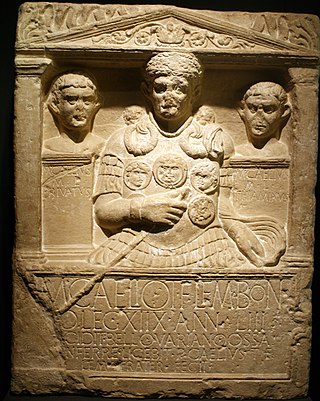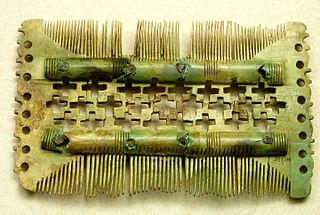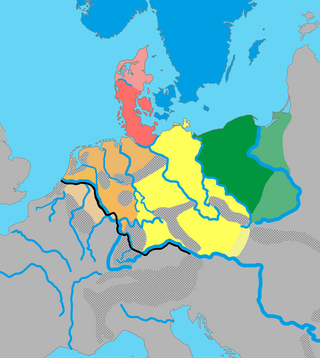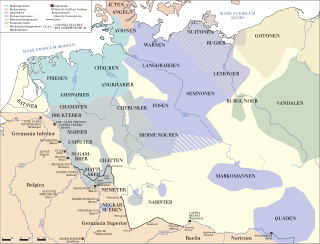
The Marcomanni were a Germanic people that established a powerful kingdom north of the Danube, somewhere near modern Bohemia, during the peak of power of the nearby Roman Empire. According to Tacitus and Strabo, they were Suebian.
Maroboduus, also known as Marbod, was a king of the Marcomanni, who were a Germanic Suebian people. He spent part of his youth in Rome, and returning, found his people under pressure from invasions by the Roman empire between the Rhine and Elbe. He led them into the forests of Bohemia, near to the Quadi who already lived nearby, and established a large alliance.

The Suebi or Suebians were a large group of Germanic peoples originally from the Elbe river region in what is now Germany and the Czech Republic. In the early Roman era they included many peoples with their own names such as the Marcomanni, Quadi, Hermunduri, Semnones, and Lombards. New groupings formed later, such as the Alamanni and Bavarians, and two kingdoms in the Migration Period were simply referred to as Suebian.

The Battle of the Teutoburg Forest, described as the Varian Disaster by Roman historians, was a major battle between Germanic tribes and the Roman Empire that took place somewhere near modern Kalkriese from September 8–11, 9 AD, when an alliance of Germanic peoples ambushed three Roman legions led by Publius Quinctilius Varus and their auxiliaries. The alliance was led by Arminius, a Germanic officer of Varus's auxilia. Arminius had acquired Roman citizenship and had received a Roman military education, which enabled him to deceive the Roman commander methodically and anticipate the Roman army's tactical responses.

The Chatti were an ancient Germanic tribe whose homeland was near the upper Weser (Visurgis), whose name might mean "pursuers". They lived in central and northern Hesse and southern Lower Saxony, along the upper reaches of that river and in the valleys and mountains of the Eder and Fulda regions, a district approximately corresponding to Hesse-Kassel, though probably somewhat more extensive. They settled within the region in the first century BC. According to Tacitus, the Batavians and Cananefates of his time, tribes living within the Roman Empire, were descended from part of the Chatti, who left their homeland after an internal quarrel drove them out, to take up new lands at the mouth of the Rhine.

The Cherusci were a Germanic tribe that inhabited parts of the plains and forests of northwestern Germany in the area of the Weser River and present-day Hanover during the first centuries BC and AD. Roman sources reported they considered themselves kin with other Irmino tribes and claimed common descent from an ancestor called Mannus. During the early Roman Empire under Augustus, the Cherusci first served as allies of Rome and sent sons of their chieftains to receive Roman education and serve in the Roman army as auxiliaries. The Cherusci leader Arminius led a confederation of tribes in the ambush that destroyed three Roman legions in the Teutoburg Forest in AD 9. He was subsequently kept from further damaging Rome by disputes with the Marcomanni and reprisal attacks led by Germanicus. After rebel Cherusci killed Arminius in AD 21, infighting among the royal family led to the highly Romanized line of his brother Flavus coming to power. Following their defeat by the Chatti around AD 88, the Cherusci do not appear in further accounts of the German tribes, apparently being absorbed into the late classical groups such as the Saxons, Thuringians, Franks, Bavarians, and Allemanni.

The Irminones, also referred to as Herminones or Hermiones, were a large group of early Germanic tribes settling in the Elbe watershed and by the first century AD expanding into Bavaria, Swabia, and Bohemia. Notably this included the large sub-group of the Suevi, that itself contained many different tribal groups, but the Irminones also included for example the Chatti.

The Quadi were a Germanic people who lived approximately in the area of modern Moravia in the time of the Roman Empire. The only surviving contemporary reports about the Germanic tribe are those of the Romans, whose empire had its border on the River Danube just to the south of the Quadi. They associated the Quadi with their neighbours the Marcomanni, and described both groups as having entered the region after the Celtic Boii had left it deserted. The Quadi may later have contributed to the "Suebian" group who crossed the Rhine with the Vandals and Alans in the 406 Crossing of the Rhine, and later founded a kingdom in northwestern Iberia.

The Thuringii, Toringi or Teuriochaimai were an early Germanic people that appeared during the late Migration Period in the Harz Mountains of central Germania, a region still known today as Thuringia. It became a kingdom, which came into conflict with the Merovingian Franks, and it later came under their influence and Frankish control. The name is still used for one of modern Germany's federal states (Bundesländer).

The Istvaeones were a Germanic group of tribes living near the banks of the Rhine during the Roman Empire which reportedly shared a common culture and origin. The Istaevones were contrasted to neighbouring groups, the Ingaevones on the North Sea coast, and the Herminones, living inland of these groups.

This is a chronology of warfare between the Romans and various Germanic peoples. The nature of these wars varied through time between Roman conquest, Germanic uprisings, later Germanic invasions of the Western Roman Empire that started in the late second century BC, and more. The series of conflicts was one factor which led to the ultimate downfall of the Western Roman Empire in particular and ancient Rome in general in 476.

The Chamavi, Chamãves or Chamaboe (Χαμαβοί) were a Germanic tribe of Roman imperial times whose name survived into the Early Middle Ages. They first appear under that name in the 1st century AD Germania of Tacitus as a Germanic tribe that lived to the north of the Lower Rhine. Their name probably survives in the region today called Hamaland, which is in the Gelderland province of the Netherlands, between the IJssel and Ems rivers.

The Dulgubnii are a Germanic tribe mentioned in Tacitus' Germania as living in what is today northwest Germany. Tacitus describes them being to the north of the Angrivarii and Chamavi, and as having moved from the north into the area once belonging to the Bructeri, between Ems, Lippe, and Weser. In this same area as the Dulgubnii, north of the Chamavi and Angrivarii, were the Chasuarii, and north of these, on the North Sea coast, where the Chauci. The Chasuarii's name is thought to derive from the River Hase which feeds into the middle of the Ems from the east, just northwest of the area associated with the Angrivarii, on the Weser. So from Tacitus, it appears that the Dulgubnii probably lived near the Weser.
Vannius was the king of the Germanic tribe Quadi.
Catualda was a Marcomannic exile who deposed the Marcomannic king Maroboduus in 18 AD.

The Elbe Germans or Elbe Germanic peoples were Germanic tribes whose settlement area, based on archaeological finds, lay either side of the Elbe estuary on both sides of the river and which extended as far as Bohemia and Moravia, clearly the result of a migration up the Elbe river from the northwest in advance of the main Migration Period until the individual groups ran into the Roman Danube Limes around 200 AD.

The Roman campaigns in Germania were a series of conflicts between the Germanic tribes and the Roman Empire. Tensions between the Germanic tribes and the Romans began as early as 17/16 BC with the Clades Lolliana, where the 5th Legion under Marcus Lollius was defeated by the tribes Sicambri, Usipetes, and Tencteri. Roman Emperor Augustus responded by rapidly developing military infrastructure across Gaul. His general, Nero Claudius Drusus, began building forts along the Rhine in 13 BC and launched a retaliatory campaign across the Rhine in 12 BC.
The Battle of the Angrivarian Wall was fought near Porta Westfalica, Germany in 16 AD between the Roman general Germanicus and an alliance of Germanic tribes commanded by Arminius. This battle followed immediately after the Battle of Idistaviso, and was supposedly sparked by Germanic outrage over the trophy erected on that prior battlefield by the Romans.
The Battle between the Hermunduri and the Chatti, popularly known as the Salt Battle was fought in Germania in 58 AD between the Chatti and the Hermunduri, both Germanic tribes.









